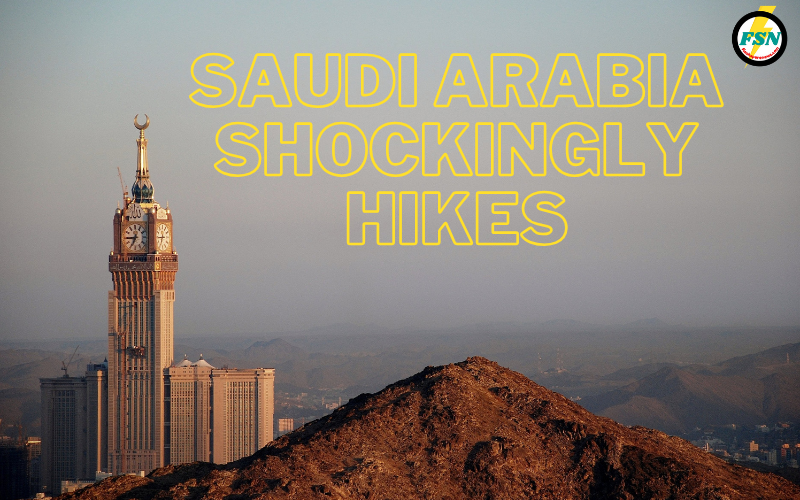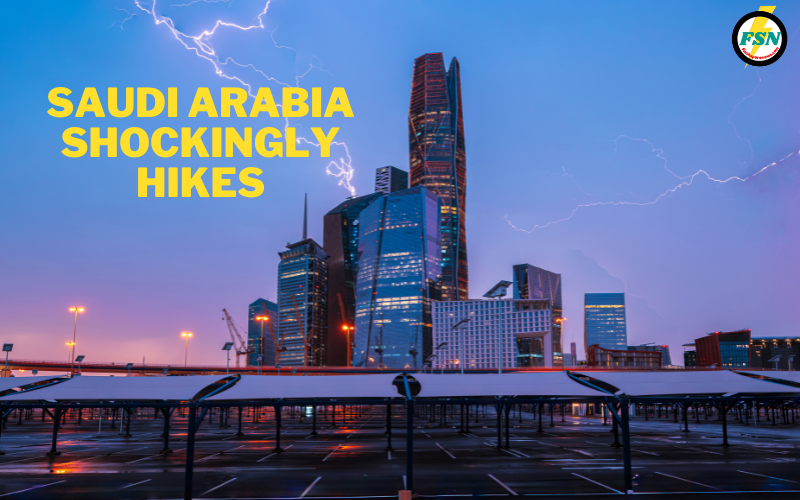Global Oil Markets Rattle as Saudi Arabia Shockingly Hikes Prices for Asia Following OPEC+ Decision

In a move that reverberated across global oil markets, Saudi Arabia shockingly hikes its main oil prices for Asia by as much as $1.50 per barrel, sending strong signals about the kingdom’s strategic intent post-OPEC+ meeting. The price adjustments, announced just a day after OPEC+ decided to begin phasing out its voluntary supply cuts, indicate Riyadh’s growing confidence in oil demand and its willingness to take bold steps to stabilize revenues amid evolving geopolitical and economic landscapes.
Saudi Arabia Shockingly Hikes Crude Prices: A Bold Post-OPEC Strategy
The announcement from Saudi Aramco, the state-owned oil giant, marks the second straight month that the kingdom has raised its official selling prices (OSPs) for its flagship Arab Light crude heading to Asia. With Asia being the top-consuming region, this decision plays a critical role in shaping global crude benchmarks. This time, the price differential increased to $3.20 per barrel above the Oman-Dubai average, a clear sign that Saudi Arabia shockingly hikes its pricing strategy to reflect a tightening market.
The timing of the move is not coincidental. Just a day earlier, the OPEC+ alliance led by Saudi Arabia and Russia agreed to gradually unwind 2.2 million barrels per day of voluntary production cuts starting October. This phased rollback is seen as an attempt to balance market stability and economic recovery, especially as global inflation shows signs of cooling and energy demand in Asia picks up pace.
Historical Context: When Saudi Arabia Last Shocked the Market
This is not the first time Saudi Arabia has used pricing as a strategic weapon. Back in 2020 during the early days of the COVID-19 pandemic, the Kingdom drastically slashed prices and ramped up production, triggering a short-lived but historic price war with Russia. The outcome of that move was catastrophic for many oil-exporting economies, but it reasserted Saudi Arabia’s dominance as the global oil price setter.
In contrast, this recent move shows evolution. Instead of flooding the market, Saudi Arabia shockingly hikes prices as part of a calculated effort to manage perception, control revenues, and sustain long-term influence. The shift from volume-based strategy to value-based pricing underlines a mature and forward-looking approach.
Global Reaction as Saudi Arabia Shockingly Hikes Crude Rates for Asian Markets
International energy analysts view the price hike as both strategic and symbolic. By adjusting prices upward so swiftly after the OPEC+ announcement, Saudi Arabia sends a strong message to both allies and competitors. It implies that the kingdom is prepared to leverage its influence to maintain pricing power in an otherwise volatile market.
Countries like India, China, South Korea, and Japan – the major buyers of Saudi oil – are expected to feel the pressure of higher procurement costs. While refiners in these countries may seek alternative sources or request discounts, Saudi Arabia’s dominant position allows it to maintain control over premium pricing tiers.
Brent crude, the international oil benchmark, responded by inching closer to $88 per barrel, showing clear signs of market tightening. Analysts now predict a sustained upward trend in oil prices throughout the third quarter, driven by reduced supply buffers and growing summer demand.
Saudi Arabia Shockingly Hikes Prices Amid Global Demand Surge and Inflation Trends
One of the key reasons Saudi Arabia shockingly hikes oil prices is the resurgence in global fuel demand, especially in Asia. Countries like India and China are experiencing strong economic rebounds, and their industrial consumption of fuel has risen significantly. In response, the kingdom has recalibrated its pricing to reflect what it sees as a seller’s market.
This decision is also closely tied to global inflation trends. As Western economies show signs of stabilizing inflation, central banks are expected to reduce interest rates, which could further stimulate demand. Saudi Arabia shockingly hikes its OSPs now to capitalize on this shift before the market becomes flooded with new supply or alternative sources such as shale oil from the United States.
Furthermore, the move may also reflect domestic economic objectives. With its Vision 2030 plan still in motion, the Saudi government seeks sustained high oil revenues to fund megaprojects such as NEOM and the Red Sea Development. By proactively managing OSPs, the country ensures consistent inflow of capital.
Refiners Respond as Saudi Arabia Shockingly Hikes August Pricing Benchmarks
The response from the refining sector was swift. Asian refiners, who rely heavily on Saudi Arabian crude due to its reliability and quality, are now forced to reconsider margins. With crack spreads narrowing, some refineries in India and China may look toward Russian or West African crude, although those options also come with logistical and geopolitical challenges.
Saudi Arabia shockingly hikes its prices at a time when Asian refining margins were already under pressure due to high input costs and subdued petrochemical demand. While the market may adjust in the short term, Saudi Arabia’s decision puts long-term supply agreements under a microscope.
Yet, for all the operational discomfort, many refiners are expected to continue sourcing Saudi crude. The geopolitical reliability of Saudi supply, its consistency in quality, and long-term contractual agreements make it difficult to pivot completely. This underlines the strategic genius behind the pricing move – aggressive but not alienating.
Saudi Arabia Shockingly Hikes Oil Rates: Market Experts Signal Price War or Calculated Strategy?
The immediate reaction to the news varied among market observers. Some saw it as the beginning of a new price war, particularly aimed at reasserting dominance over emerging exporters like the U.S. and Russia. Others viewed it as a calculated strategy to gradually normalize prices while maintaining a leadership image within OPEC+.
According to data from S&P Global, Saudi Arabia shockingly hikes OSPs to create a deliberate price corridor for Middle Eastern crude. The kingdom’s goal may be to prevent undercutting from other producers while encouraging strategic stockpiling among buyers.

This approach also serves as a psychological nudge. By implementing hikes consistently and aggressively, Saudi Arabia conditions the market to accept new pricing norms. In this way, buyers begin to expect – rather than resist – elevated costs, especially when supply remains constrained.
Saudi Arabia Shockingly Hikes Prices: Will It Trigger a Domino Effect Among Oil Exporters?
There’s now growing speculation that other OPEC producers may follow suit. Historically, Saudi Arabia sets the tone for pricing in the Middle East. If buyers continue to accept the higher rates, other exporters like the UAE, Kuwait, and Iraq might also raise their OSPs.
Saudi Arabia shockingly hikes prices not just as a domestic policy but also as an international cue. The signal is clear: the days of cheap oil may be behind us, at least for the foreseeable future.
In the coming weeks, all eyes will be on the next set of price declarations from regional exporters. A synchronized hike could intensify inflationary pressures globally, potentially altering central bank strategies and trade dynamics.
Impact on Domestic Policies in Asia as Saudi Arabia Shockingly Hikes Crude Rates
Governments in Asia are under pressure to cushion the impact of Saudi Arabia’s price hikes on their domestic economies. India and Indonesia have already begun discussions on subsidizing fuel prices or adjusting tax rates to prevent consumer backlash.
Japan, which imports nearly all of its oil, is considering emergency stock releases and price stabilization funds. China, on the other hand, is expected to use state reserves strategically while simultaneously increasing its investments in alternative energy sources.
The phrase “Saudi Arabia shockingly hikes” is now part of fiscal planning discussions in finance ministries across Asia. It’s not just an energy concern—it’s a macroeconomic trigger influencing inflation forecasts, trade balances, and even interest rate decisions.
Geopolitical Ripple Effects as Saudi Arabia Shockingly Hikes Prices
The hike has not only impacted economics but also geopolitics. The United States, traditionally a Saudi ally, may find itself in a diplomatic bind as higher oil prices could counteract domestic anti-inflation efforts. The Biden administration has already expressed concern over potential inflationary pressures from OPEC+ actions.
Meanwhile, Russia could benefit indirectly from the price hikes, as it allows Moscow to sell its crude at better margins despite Western sanctions. Iran, too, sees this as an opportunity to strengthen ties with Asian importers seeking price relief.
Saudi Arabia shockingly hikes its oil prices with an understanding that it is also shaping global alliances. The pricing policy becomes a form of soft power—used to influence diplomatic alignments and regional partnerships.
Expert Opinions and Forecasts: What Comes Next?
Experts from institutions like Goldman Sachs, JP Morgan, and the International Energy Agency (IEA) have weighed in. Many believe oil prices could breach $95 per barrel by Q4 2025 if demand continues rising and supply remains disciplined. Some predict even $100+ scenarios if geopolitical tensions flare up in the Middle East.
Consulting firms like Wood Mackenzie and Rystad Energy point out that Saudi Arabia’s actions are not just about today’s market—they’re about reshaping expectations for the next decade. They argue that by normalizing higher price floors, the Kingdom ensures long-term sustainability even amid global energy transition.
Environmental Concerns and Technological Shift
While Saudi Arabia shockingly hikes prices, environmental groups worry that higher fuel costs could stall climate progress in some developing nations. However, in advanced economies, it may actually hasten green adoption. EV markets are expected to benefit from the price surge, with consumers seeing higher savings in operational costs.
The global solar and wind sector may also get a boost, as governments reallocate energy budgets toward sustainable sources. Thus, paradoxically, Saudi Arabia’s pricing strategy might act as a silent catalyst for global energy diversification.
Conclusion: Saudi Arabia Shockingly Hikes Prices, Resets Market Dynamics Globally
The world has entered a new phase in energy pricing. Saudi Arabia shockingly hikes its oil prices with precision, timing, and boldness that is likely to redefine market dynamics well into 2025. For energy-importing nations, this could mean higher transportation and manufacturing costs. For oil exporters, it could be the start of a new era of pricing discipline and revenue stabilization.
As demand continues to rise and supply remains cautiously managed, Saudi Arabia’s role as the world’s oil price setter becomes even more prominent. The message is unmistakable – Riyadh will not shy away from using its market power to secure its national and economic interests.
This shock pricing maneuver may well be studied for years to come as a masterstroke in oil diplomacy – one that reshaped expectations, markets, and the energy narrative itself.

